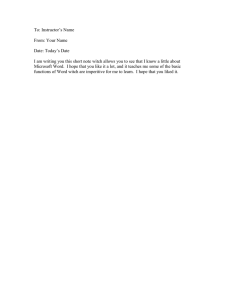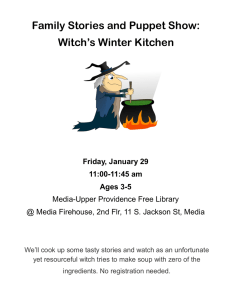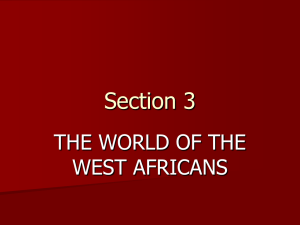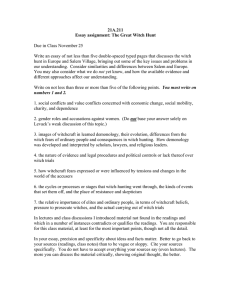AFRICAN ANIMISM SUB-SAHARAN AFRICAN CULTURE
advertisement
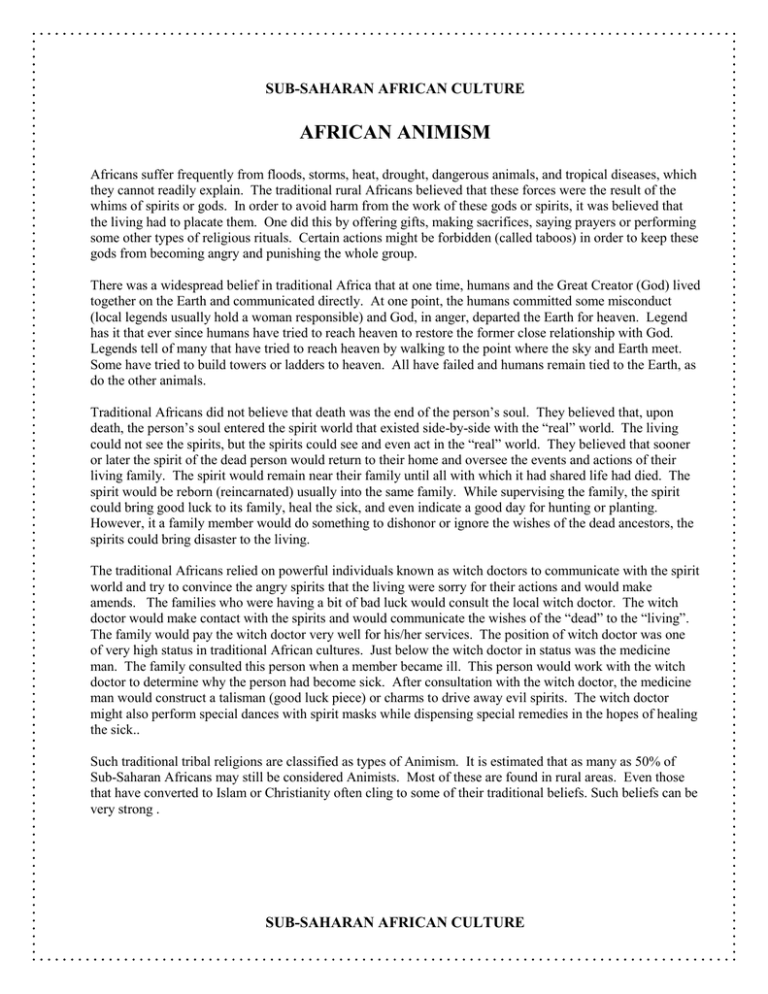
SUB-SAHARAN AFRICAN CULTURE AFRICAN ANIMISM Africans suffer frequently from floods, storms, heat, drought, dangerous animals, and tropical diseases, which they cannot readily explain. The traditional rural Africans believed that these forces were the result of the whims of spirits or gods. In order to avoid harm from the work of these gods or spirits, it was believed that the living had to placate them. One did this by offering gifts, making sacrifices, saying prayers or performing some other types of religious rituals. Certain actions might be forbidden (called taboos) in order to keep these gods from becoming angry and punishing the whole group. There was a widespread belief in traditional Africa that at one time, humans and the Great Creator (God) lived together on the Earth and communicated directly. At one point, the humans committed some misconduct (local legends usually hold a woman responsible) and God, in anger, departed the Earth for heaven. Legend has it that ever since humans have tried to reach heaven to restore the former close relationship with God. Legends tell of many that have tried to reach heaven by walking to the point where the sky and Earth meet. Some have tried to build towers or ladders to heaven. All have failed and humans remain tied to the Earth, as do the other animals. Traditional Africans did not believe that death was the end of the person’s soul. They believed that, upon death, the person’s soul entered the spirit world that existed side-by-side with the “real” world. The living could not see the spirits, but the spirits could see and even act in the “real” world. They believed that sooner or later the spirit of the dead person would return to their home and oversee the events and actions of their living family. The spirit would remain near their family until all with which it had shared life had died. The spirit would be reborn (reincarnated) usually into the same family. While supervising the family, the spirit could bring good luck to its family, heal the sick, and even indicate a good day for hunting or planting. However, it a family member would do something to dishonor or ignore the wishes of the dead ancestors, the spirits could bring disaster to the living. The traditional Africans relied on powerful individuals known as witch doctors to communicate with the spirit world and try to convince the angry spirits that the living were sorry for their actions and would make amends. The families who were having a bit of bad luck would consult the local witch doctor. The witch doctor would make contact with the spirits and would communicate the wishes of the “dead” to the “living”. The family would pay the witch doctor very well for his/her services. The position of witch doctor was one of very high status in traditional African cultures. Just below the witch doctor in status was the medicine man. The family consulted this person when a member became ill. This person would work with the witch doctor to determine why the person had become sick. After consultation with the witch doctor, the medicine man would construct a talisman (good luck piece) or charms to drive away evil spirits. The witch doctor might also perform special dances with spirit masks while dispensing special remedies in the hopes of healing the sick.. Such traditional tribal religions are classified as types of Animism. It is estimated that as many as 50% of Sub-Saharan Africans may still be considered Animists. Most of these are found in rural areas. Even those that have converted to Islam or Christianity often cling to some of their traditional beliefs. Such beliefs can be very strong . SUB-SAHARAN AFRICAN CULTURE AFRICAN ANIMISM QUESTIONS 1. Why do people believe in animism? 2. Is animism a traditional or modern religion? 3. What do people who believe in animism think is their purpose for going to heaven? 4. How do they believe that one gets to heaven? 5. What do believers think is the purpose of the dead? 6. What happens if a family member were to do something to dishonor a dead ancestor? 7. What is the difference between a witch doctor and a medicine man? witch doctor – medicine man – 8. Who do they believe heals the ill? How? 9. Compare this religion to your own. similarities – differences - The Diviner Orunmila, the god of destiny, had always guided Banji’s life. Before he was born his parents had gone to a diviner to discover what they might do to have a healthy baby because three children born to them had died in infancy. Banji was born a healthy baby. When Banji was 8, he had become ill, and the process of divination had been carried out in order to learn why. The diviner suggested that Banji was now a young man, and it was time for him to take a wife. He needed someone who could help him with the farming, who would cook for him and most importantly, someone who would bear strong sons to carry on the family line. For some time, Banji had his eye on Adesina, a beautiful, strong, young girl from the town of Ilorin. They had met in the market place and had since spent much time in each other’s company. As was the custom of this people, Banji first spoke to his father about his desire for a wife and for Adesina in particular. “I have heard that her family is a good one, “ Banji’s father said. “I will visit them with gifts of kola nuts and palm wine to see how they feel about the marriage. He did this, taking his brother with him, for among the Yoruba people, it is customary to involve the entire family in such affairs. Adesina’s parents were receptive to the match. But since marriage was such an important step, they knew to seek the advice of a diviner to see if the marriage was part of her destiny. As in many African societies, the Yoruba believe in one Supreme God (Olodumare) who created & controls the universe. But, they also believe in a wide range of lesser divinities who owe their existence to Olodumare but who are concerned with specific aspects of man’s activities. There are among the Yoruba, for example, a god of the farm, a god of the rivers and fish, and many others. Africans choose to call on those deities, which are most likely to help with a particular problem. Adesina’s family wished to consult the deity Orunmila, the god of destiny, who could read the future. Access to this god was through the process of divining. So Adesina’s father and grandfather visited a well-known diviner who had access to Orunmila. The diviner spoke to them briefly, then proceeded solemnly to the task at hand. First, he called on Orunmila and gave an offering of kola nuts. Then, taking 16 palm nuts from a large wooden bowl, he began to toss them from one hand to the other. When only one or two nuts were left in his right hand, he made small marks on a wooden board. He continues this process eight times until he had eight sets of marks on the board. Looking carefully at the marks, he interprets them and learns what prophecy would be most appropriate to recite. He then recited the lengthy prophecy, which gave hints as to what the couple must do to receive deity approval for the marriage. Once this had been completed, the terms of marriage were agreed upon, and the couple became formally engaged. Banji was happy. Orunmila had indicated that the match was acceptable with his destiny. Soon the lovely Adesina would be his wife and together they would have many children to make a fine family of their own. www.abgekfure.cin/biz2/BRW/index.html The Diviner 1. How does Banji (and his family) go about choosing a wife? 2. How would you describe the work of a diviner? 3. Identify practices in your culture for telling the future. 4. According to the story, when does one seek the help of a diviner? 5. Many Africans believe that their deities frequently intervene directly in people’s lives. What evidence can be found in the story to support this statement.? 6. If you were living by Yoruba culture, at what time in your life would you consult a diviner?
